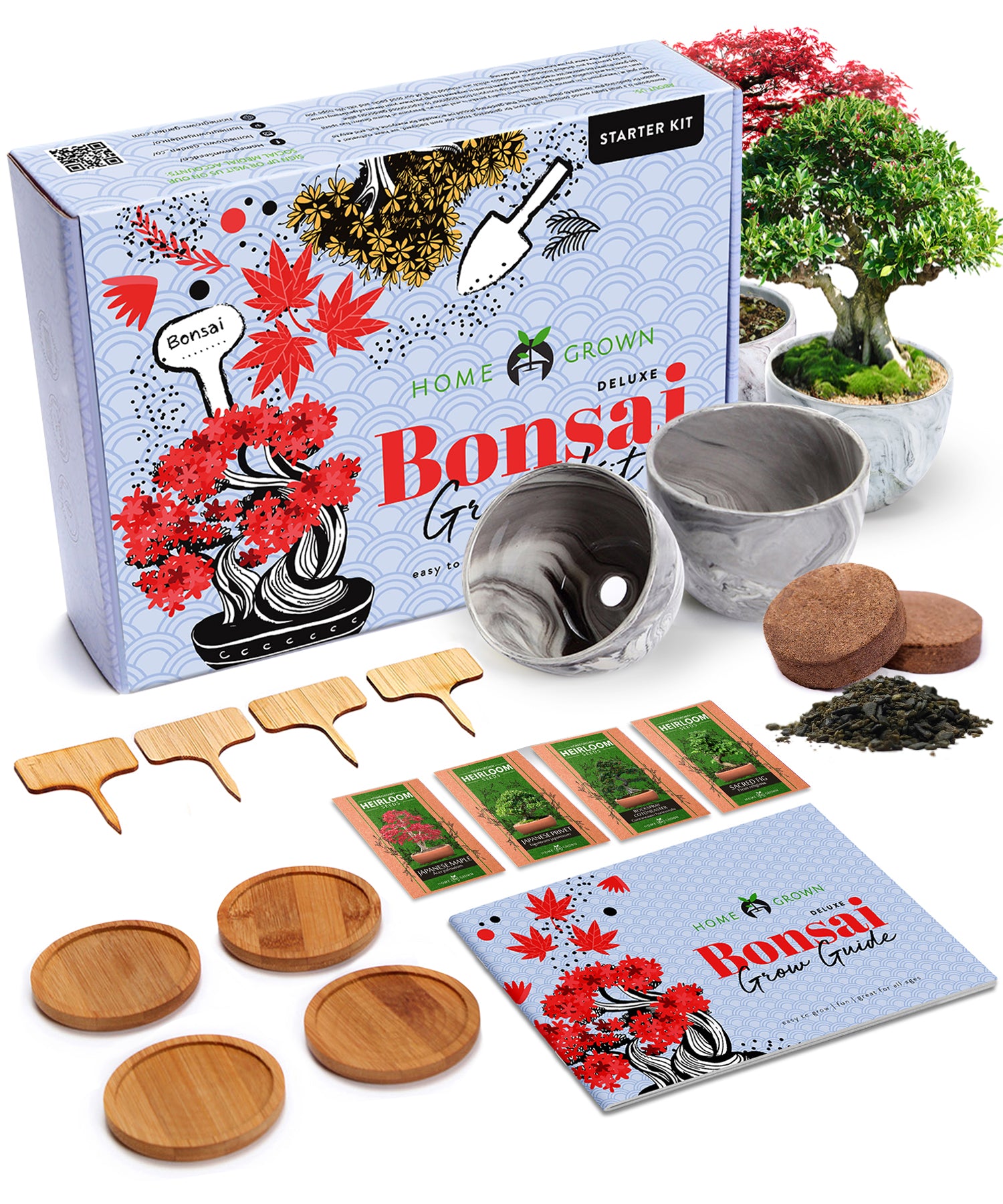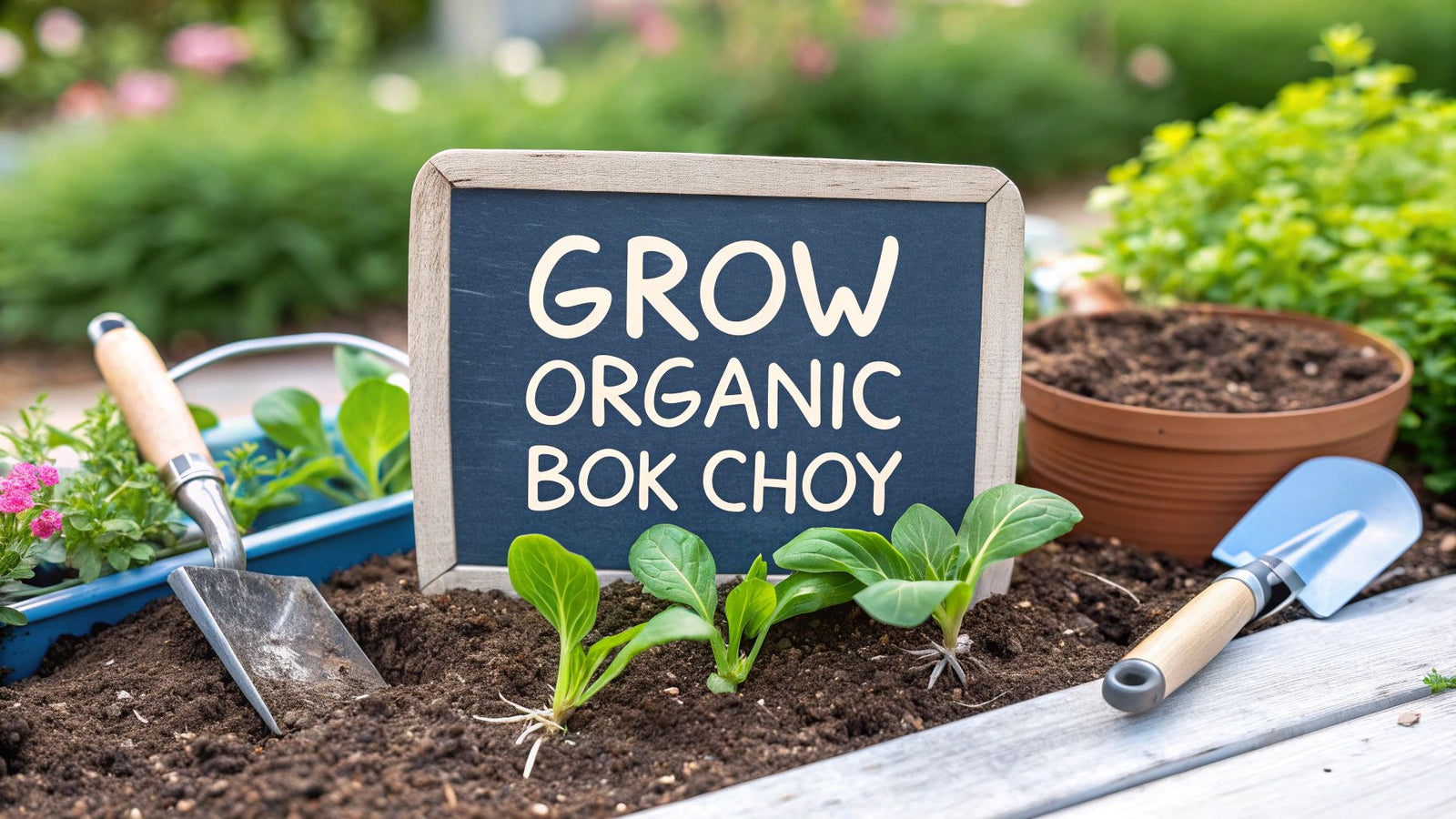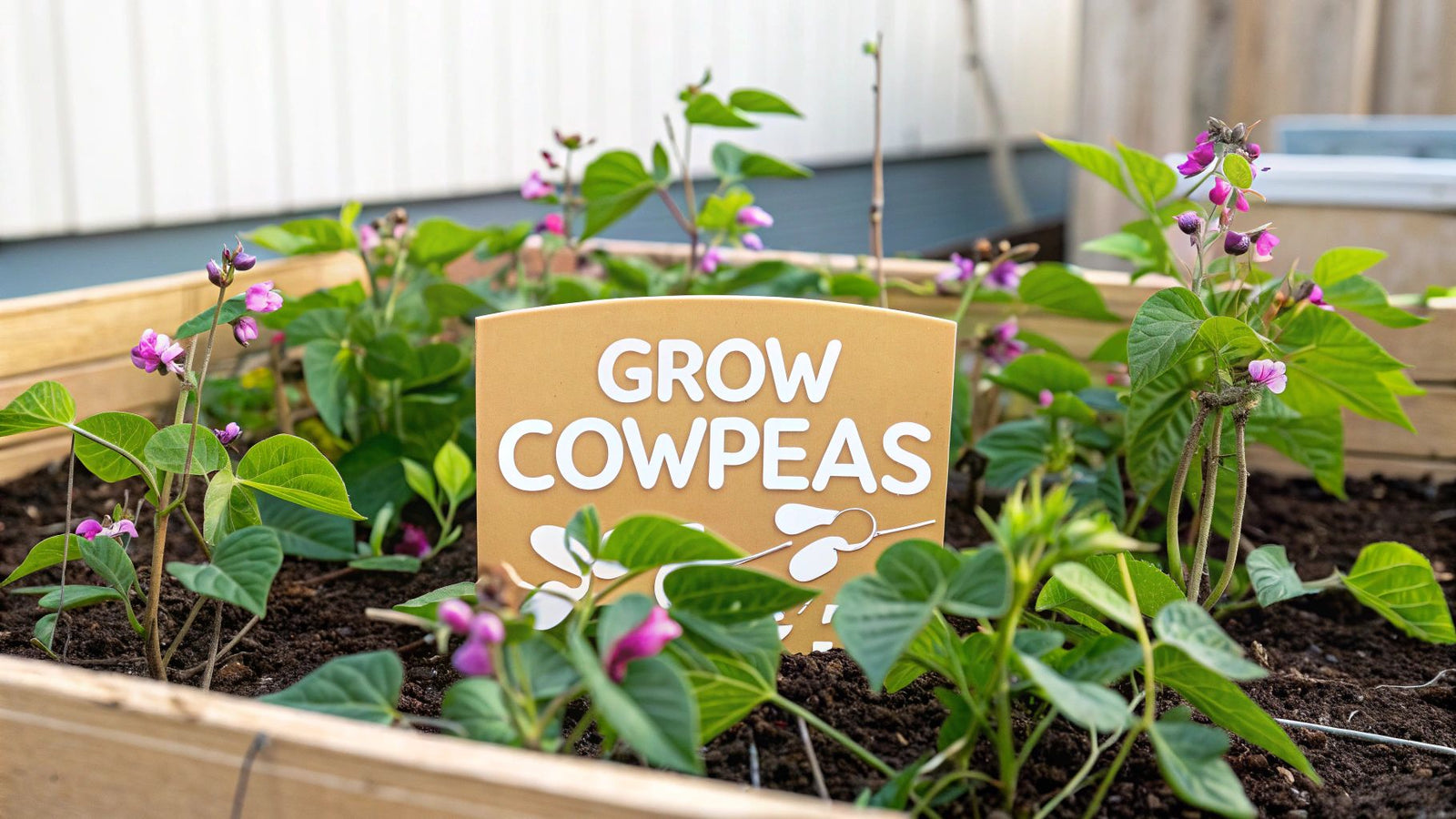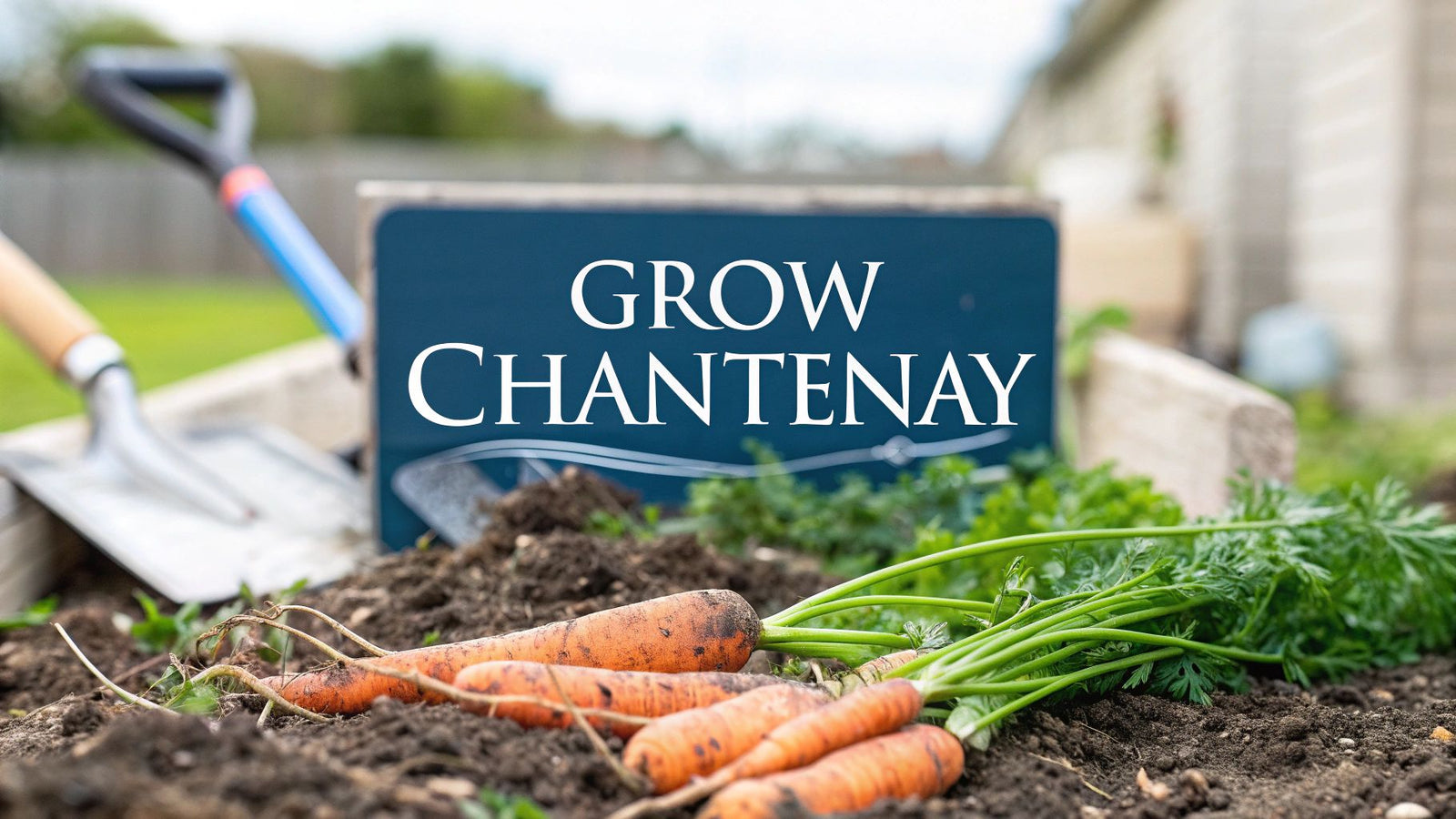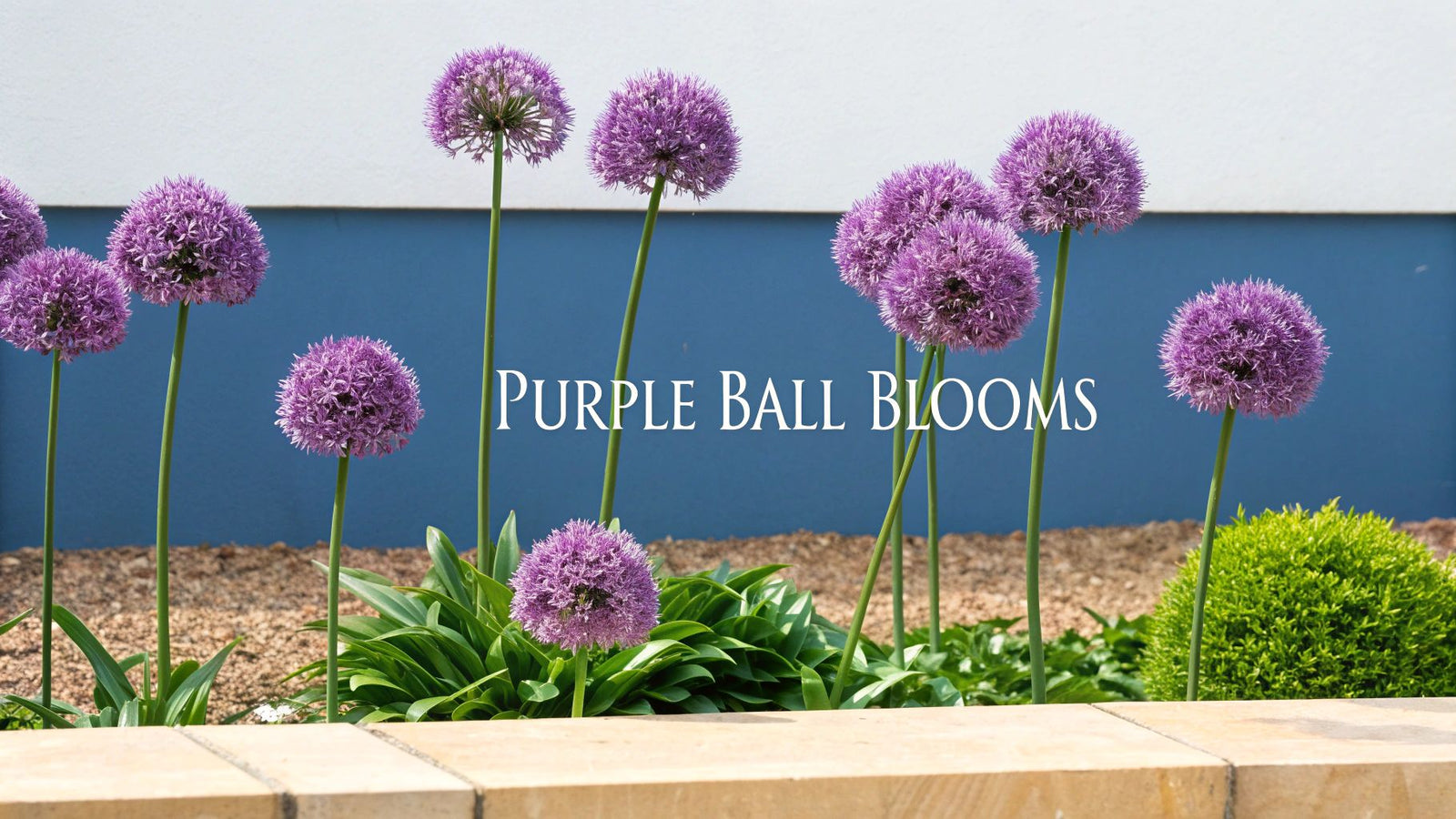
Imagine your garden filled with striking, perfectly round purple blooms, bobbing like magical orbs above the foliage. These architectural wonders aren't just beautiful; they add structure, texture, and a touch of modern elegance that transforms an ordinary space into a designer landscape. The unique spherical shape of these blossoms provides a stunning contrast to more traditional flower forms, creating visual interest that lasts throughout the season. For gardeners seeking to add a dramatic flair with minimal fuss, these reliable bloomers are an exceptional choice.
This guide moves beyond simple suggestions to provide a detailed look at 6 of the best perennial flowers with purple ball-shaped blooms. We'll cover everything from planting the iconic Allium 'Purple Sensation' to caring for the resilient Globe Thistle, ensuring you have the specific, actionable advice needed for success. You will learn the ideal soil conditions, sunlight requirements, and expert tips for each variety, empowering you to cultivate these captivating spheres. Prepare to discover the secrets to growing these unique perennial flowers purple ball varieties and creating a garden that stops passersby in their tracks. We'll explore everything from planting dramatic giants to nurturing compact, pollinator-friendly options suitable for any garden size.
1. How to Grow Allium hollandicum 'Purple Sensation'
When you envision the perfect sphere of purple in a garden, chances are you're picturing Allium hollandicum 'Purple Sensation'. This iconic ornamental onion stands as a titan in the world of garden design, celebrated for its jaw-dropping, perfectly spherical flower heads. Each globe is a dense cluster of tiny, star-shaped, deep violet flowers, creating a dramatic and geometric focal point.
'Purple Sensation' provides a stunning vertical accent, with its 3- to 4-inch flower heads perched atop tall, slender, yet surprisingly sturdy stems. This structure allows them to float above lower-growing perennials, adding a layer of architectural interest. Its unique form has made it a favorite of renowned designers like Piet Oudolf, who frequently uses it in large drifts to create breathtaking displays in public spaces, including New York City’s High Line.
Key Characteristics at a Glance
For a quick reference, the infographic below summarizes the essential measurements of 'Purple Sensation', highlighting its impressive scale and bloom time.
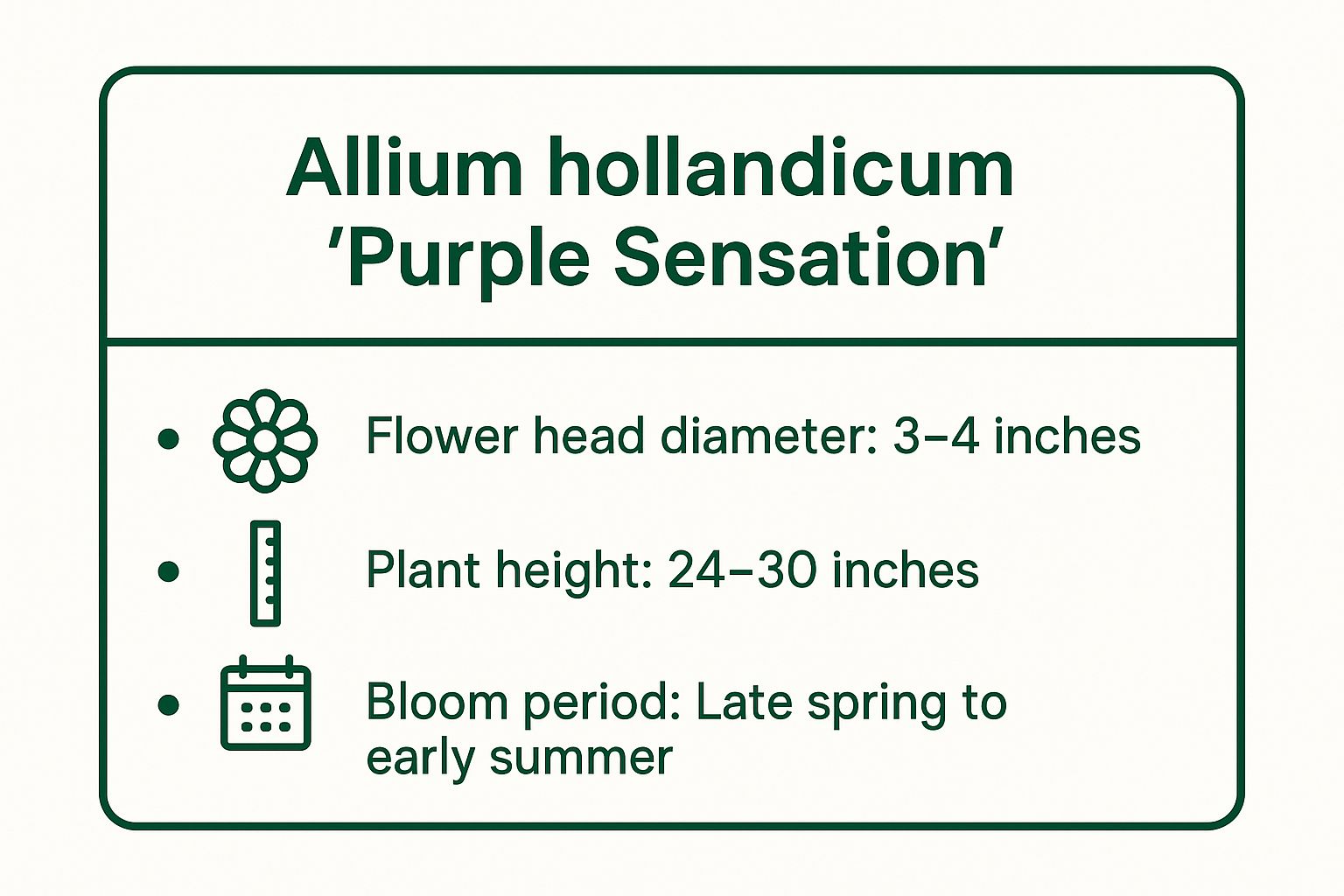
These key stats show why 'Purple Sensation' is such a powerful design tool, offering significant height and a substantial bloom that commands attention during its late spring to early summer show.
Planting and Care Tips
To successfully incorporate this striking perennial flower with its purple ball shape into your garden, timing and placement are crucial.
- Planting: Bulbs should be planted in the fall, about 4-6 inches deep and spaced 4-6 inches apart. Planting in groups of five or more creates the most impactful visual statement.
- Sunlight: For the most vibrant color and strongest stems, plant in a location that receives at least six hours of direct sunlight daily.
- Foliage Camouflage: A common characteristic of ornamental alliums is that their strappy foliage begins to yellow and die back just as the flowers emerge. To hide this, interplant them with companions like hostas, geraniums, or ornamental grasses whose leaves will unfurl just in time to cover the fading allium foliage.
Expert Insight: One of the greatest benefits of 'Purple Sensation' is its extended season of interest. After the vibrant purple fades, the architectural seed heads remain, providing texture and form well into the winter. Avoid the urge to deadhead them immediately.
This RHS Award of Garden Merit recipient is not just beautiful; it's also remarkably low-maintenance, drought-tolerant once established, and highly resistant to deer and rodents, making it a reliable and spectacular choice for nearly any sunny garden.
2. How to Grow Echinops ritro (Globe Thistle)
For those who appreciate texture and architectural drama, Echinops ritro, commonly known as Globe Thistle, offers a unique take on the purple ball perennial flower. This robust plant features spiky, steel-blue to deep lavender spherical flower heads that have an almost metallic sheen. Resembling a sea urchin, each globe is a composite of many tiny, star-like florets, creating a fascinating textural element that stands out in any garden bed or border.
Globe Thistle’s coarse, thistle-like, silvery-green foliage provides a striking contrast to its vibrant blooms, adding to its rugged charm. This plant’s tough, drought-tolerant nature makes it a favorite in low-water gardens and xeriscapes, as seen in the renowned xerophytic plantings at the Denver Botanic Gardens. Its unique form was championed by influential designers like Beth Chatto, who prized it for its resilience and structural beauty in her iconic gravel garden.
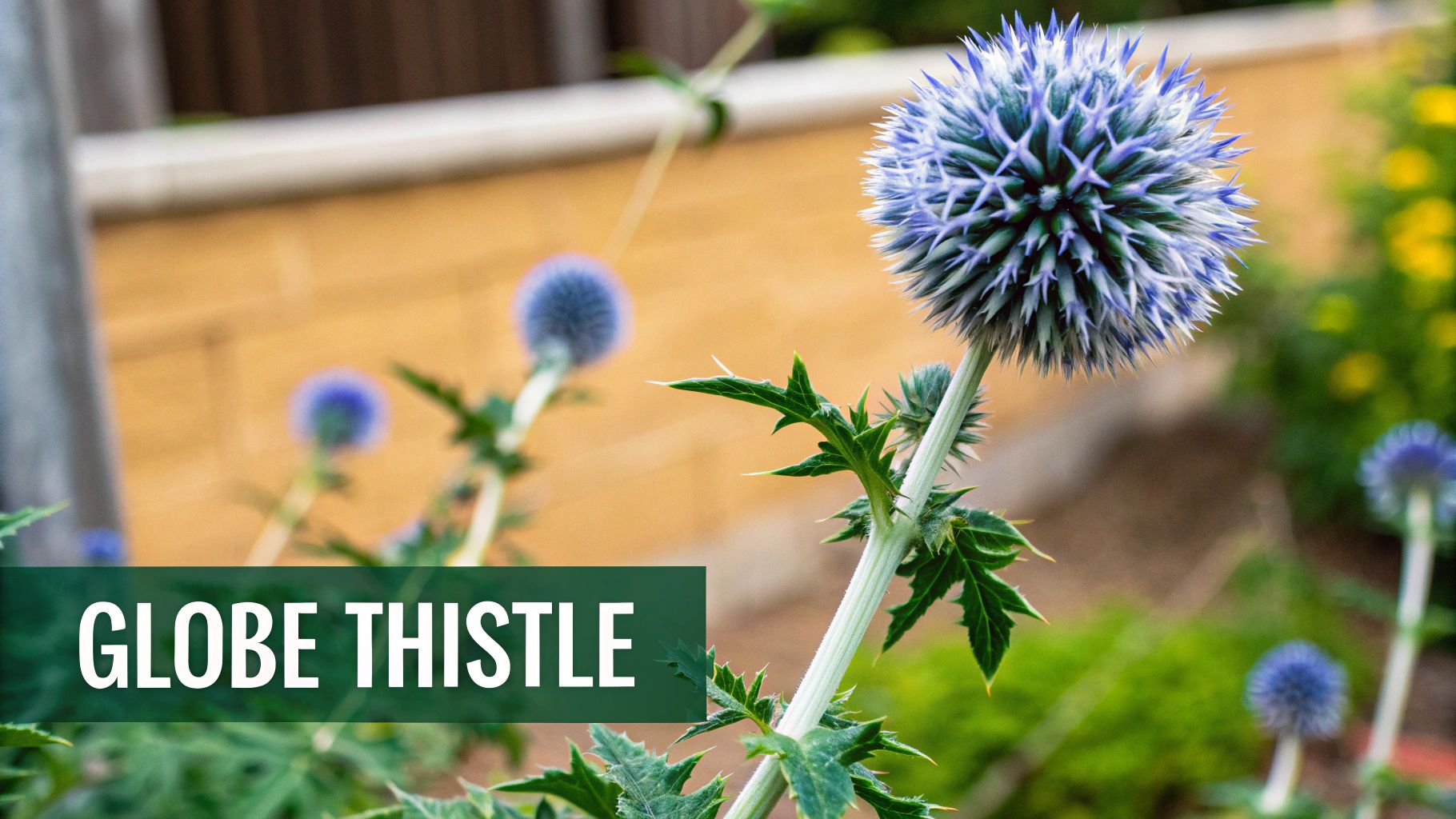
Key Characteristics at a Glance
The Globe Thistle is valued for its mid-summer bloom time and its impressive, self-sufficient stature. Its key measurements demonstrate why it’s a staple for adding texture and height when many other perennials are beginning to fade.
- Height: 24-48 inches (60-120 cm)
- Spread: 18-30 inches (45-75 cm)
- Bloom Size: 1-2 inches (2.5-5 cm) in diameter
- Bloom Time: Mid to late summer
- Hardiness Zones: 3-8
These characteristics make Echinops ritro a reliable and visually arresting perennial flower with a distinctive purple ball shape, perfect for sunny, dry locations. For more details on this and other purple perennials, you can learn more about purple perennial flower identification on homegrown-garden.com.
Planting and Care Tips
Successfully growing Globe Thistle hinges on providing the right conditions, particularly when it comes to soil and spacing.
- Drainage is Key: This plant thrives in poor, dry to medium, well-drained soils and full sun. It absolutely despises wet feet, so avoid heavy clay soils that retain moisture.
- Spacing: To prevent overcrowding and ensure good air circulation, space plants 24-36 inches apart. This allows them to reach their mature size without competing for resources.
- Handling: The foliage and stems are spiny. Always wear gloves when planting, dividing, or cutting this plant to protect your hands.
- Propagation: It can be grown from seed started in early spring or from root cuttings or divisions taken in the fall or spring.
Expert Insight: The Globe Thistle is a magnet for pollinators like bees and butterflies. After the flowers fade, the seed heads maintain their spherical shape and provide winter interest, as well as food for birds like goldfinches. They also make exceptional dried flowers; cut the stems just as the florets begin to open for the best color and form retention.
This tough, low-maintenance perennial is highly resistant to deer and rabbits. Its distinctive spiky texture and cool-toned purple globes make it an invaluable addition for creating contrast and extending seasonal interest in the garden.
3. How to Grow Allium giganteum (Giant Allium)
For the gardener seeking a true showstopper, Allium giganteum is the undisputed king. As its name suggests, this is the giant of the ornamental onion family, producing enormous, tightly packed spheres of lilac-purple flowers. These incredible globes can reach up to 6 inches in diameter and sit majestically atop towering, thick stems that can soar to 4 feet or more, creating an unforgettable architectural statement in the late spring and early summer garden.
This Central Asian native is the crown jewel of the allium world, a living sculpture that brings a sense of drama and scale unmatched by most other perennials. Its sheer size and perfect form make it a focal point that draws the eye and sparks conversation. You can find Allium giganteum used to spectacular effect in world-renowned gardens, from the iconic spring displays at Keukenhof Gardens in the Netherlands to the sophisticated perennial borders at Great Dixter in England, a testament to its powerful design impact.
Key Characteristics at a Glance
The infographic below outlines the impressive dimensions and bloom schedule of Allium giganteum, showcasing why it’s a premier choice for adding vertical drama.
These vital statistics highlight the plant's massive scale. Its towering height and colossal bloom size demand careful placement to be fully appreciated and supported.
Planting and Care Tips
Successfully growing this magnificent perennial flower with its purple ball shape requires a bit of planning to accommodate its grand proportions.
- Planting: Plant the large bulbs in the fall, setting them about 6-8 inches deep and 8-10 inches apart to give each plant enough space. Planting in groups of odd numbers, like three or five, creates a more natural and visually appealing clump.
- Sunlight and Location: Full sun is essential for the strongest stems and best flowering. Choose a site protected from strong winds, as the tall stems can be vulnerable to breakage despite their thickness.
- Support and Foliage: The broad, strap-like leaves will begin to wither before the flowers open. Plant them among later-emerging perennials like peonies, catmint, or tall grasses to obscure the declining foliage. Consider placing support stakes early in the season before the stems reach their full height.
Expert Insight: The legacy of gardeners like Christopher Lloyd of Great Dixter showcases the power of using Allium giganteum not just as a specimen, but as a repeated element that brings rhythm and structure to large borders. Don't be afraid to go big with your planting numbers for maximum effect.
Thanks to its commanding presence and robust nature, this giant allium is also highly resistant to deer and rodents. It is a fantastic, low-maintenance choice for creating breathtaking garden moments that persist long after the color fades, as its seed heads provide interest for months.
4. How to Grow Monarda fistulosa (Wild Bergamot)
For a more relaxed and wild take on the perennial flowers purple ball theme, Monarda fistulosa, commonly known as Wild Bergamot, offers a uniquely beautiful form. This North American prairie native produces distinctive, pompom-like flower heads that are less a perfect sphere and more of a wonderfully disheveled globe. Each head is a complex cluster of tubular, lavender to pinkish-purple florets, creating a spiky, firework-like appearance that adds texture and movement to the garden.
Wild Bergamot is a powerhouse for attracting pollinators, drawing bees, butterflies, and hummingbirds in droves. Its value extends beyond its ornamental appeal; it's a staple in naturalistic garden designs championed by pioneers like Piet Oudolf and is a key component in prairie restorations, like those seen in Chicago's Lurie Garden. Its fragrant leaves, reminiscent of mint and oregano, also make it a favorite in herb and therapeutic gardens.
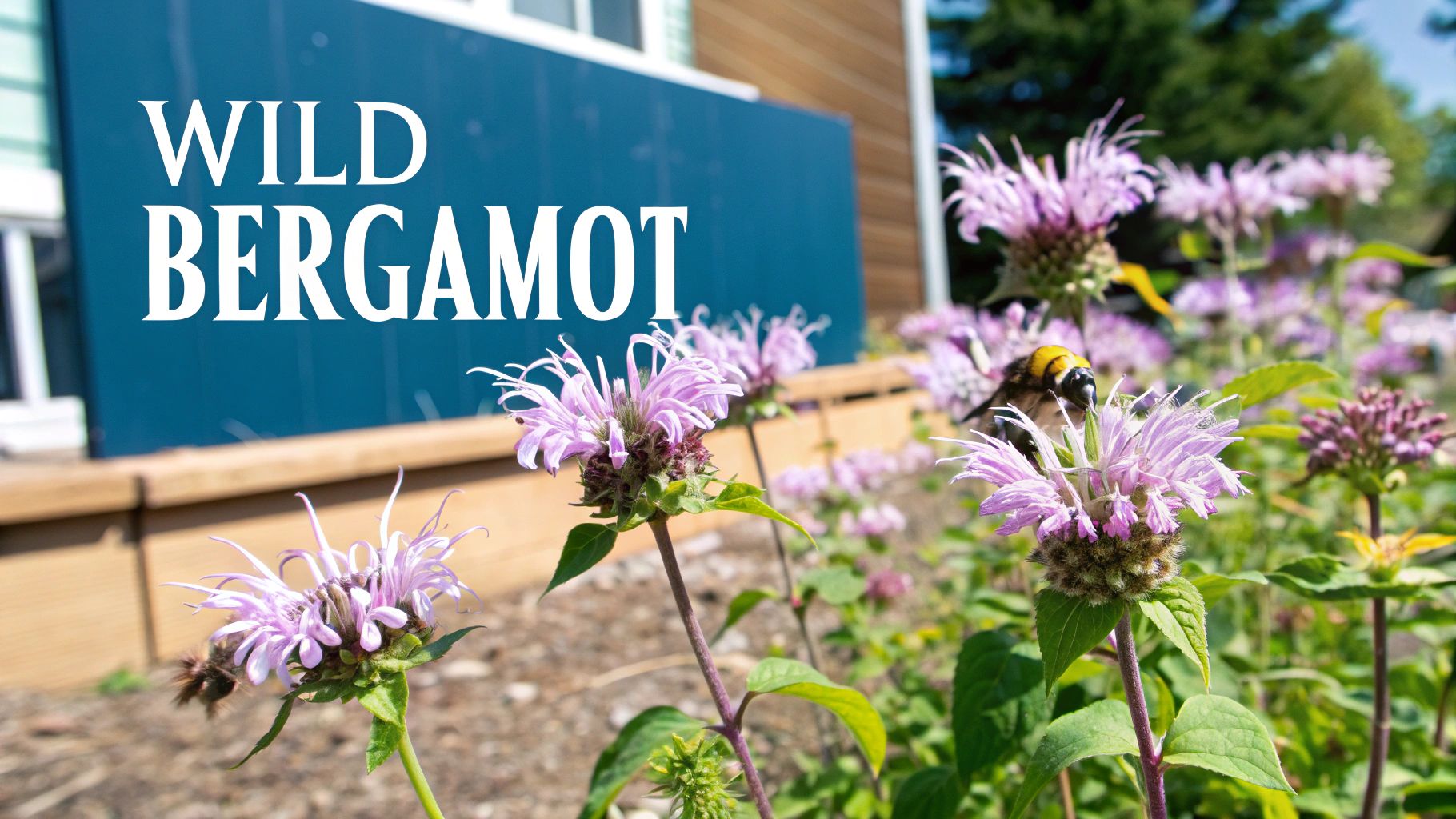
This plant’s mid to late summer bloom time is a significant advantage, providing a burst of purple when many other perennials are starting to fade. It bridges the gap between early summer bloomers and the autumn performers, ensuring continuous color and pollinator activity in your landscape.
Planting and Care Tips
To get the most from this hardy native perennial and its unique purple ball-shaped flowers, proper care is straightforward but essential.
- Planting: Plant in the spring after the danger of frost has passed. Space plants 18-24 inches apart to give them room to spread and ensure good air circulation, which is key to preventing powdery mildew.
- Sunlight: While it can tolerate partial shade, Wild Bergamot thrives and flowers most prolifically in full sun, requiring at least six hours of direct light daily.
- Maintenance: Deadhead spent blooms regularly to encourage a longer flowering period. To maintain plant vigor and prevent overcrowding, divide the clumps every 3-4 years in the spring. If you are curious about its bloom cycle, you can find helpful timelines for various native species and learn more about when your wildflowers will bloom.
Expert Insight: Good air circulation is the best defense against powdery mildew, a common issue for Monardas. Avoid overhead watering and consider thinning stems in dense clumps if mildew becomes a persistent problem.
As a member of the mint family, Wild Bergamot is exceptionally tough, deer-resistant, and relatively drought-tolerant once established. It’s an ideal choice for gardeners looking to create a beautiful, low-maintenance, and ecologically valuable garden that hums with life.
5. How to Grow Allium aflatunense (Persian Onion)
For gardeners seeking the classic allium aesthetic in a slightly more delicate and accessible form, Allium aflatunense is an exceptional choice. Hailing from Central Asia, this species, often called the Persian Onion, produces graceful, 4-inch lilac-purple globes that are densely packed with tiny, star-like flowers. It offers a softer, more ethereal presence compared to some of its bolder relatives, making it a versatile perennial flower with a purple ball shape.
The Persian Onion provides elegant vertical structure without overwhelming a planting scheme. Its slender, strong stems elevate the floral spheres above surrounding foliage, creating a beautiful layered effect. This allium is a favorite for naturalizing in meadows or creating large, sweeping drifts in borders, a technique beautifully employed in famous public spaces like Sissinghurst Castle Garden. Its affordability and willingness to multiply make it perfect for achieving high-impact mass plantings.
Key Characteristics at a Glance
While slightly more modest in scale than giants like 'Globemaster', A. aflatunense still delivers significant visual impact. Its manageable size makes it an excellent addition to gardens of all scales, from compact urban plots to expansive country borders. The combination of its height and bloom size ensures it stands out as a key player in the late spring garden.
These vital statistics illustrate how the Persian Onion bridges the gap between smaller alliums and the larger-than-life cultivars, providing substantial form and color.
Planting and Care Tips
To get the most from this elegant perennial, proper planting and care are essential. It is a forgiving plant that rewards thoughtful placement with years of beauty.
- Planting: Plant the bulbs in the fall, setting them about 5-6 inches deep in well-draining soil. Spacing them 6-8 inches apart will give them ample room to establish and begin forming a natural, self-sustaining colony.
- Sunlight: Full sun is ideal for promoting the strongest stems and the most intense purple coloration in the blooms.
- Foliage Camouflage: Like other ornamental onions, its foliage starts to fade as the flowers open. Plant it among companions like daylilies, hostas, or catmint, whose emerging leaves will gracefully hide the declining allium foliage.
Expert Insight: A key benefit of Allium aflatunense is its ability to self-seed and naturalize where it's happy. After flowering, allow the decorative seed heads to stand through autumn. This not only adds structural interest but also allows the plant to gently spread, creating a more robust and natural-looking display over time. While you can learn about more advanced techniques like how to propagate plants in water on homegrown-garden.com, this allium does much of the work for you.
This species is prized in sustainable landscape design for its low-maintenance nature. It is highly drought-tolerant once established and is dependably resistant to deer, rabbits, and other garden pests, making it a reliable and beautiful choice for almost any sunny location.
6. How to Grow Gomphrena globosa 'Purple Baron' (Globe Amaranth)
While many purple ball-shaped flowers peak in spring, Globe Amaranth offers a non-stop display of vibrant color through the hottest days of summer. Gomphrena globosa 'Purple Baron' is a workhorse in the garden, producing dozens of perfectly round, clover-like flower heads with a unique, papery texture. These one-inch globes are a rich, saturated magenta-purple, standing out vividly against their deep green foliage.
Originally from Central America, this plant's exceptional heat and drought tolerance has made it a favorite among Southern gardening experts and commercial landscapers. 'Purple Baron' provides consistent, reliable blooms when other plants wilt under pressure, making it an essential perennial flower with a purple ball shape for challenging sunny spots. Its sturdy, well-branched habit creates a neat, mounded form that works beautifully in borders, containers, and mass plantings.
Key Characteristics at a Glance
Unlike the towering Alliums, 'Purple Baron' offers a more compact yet equally impactful presence. Its continuous blooming cycle and modest size make it a versatile choice for filling in gaps and providing season-long interest.
- Height: 16-20 inches
- Spread: 8-10 inches
- Bloom Size: 1 inch diameter
- Bloom Time: Early summer to first frost
- Hardiness Zones: 9-11 (grown as a warm-season annual elsewhere)
These stats highlight its role as a long-blooming filler and border plant, providing a steady supply of color and texture from summer until fall.
Planting and Care Tips
To get the most out of this resilient bloomer, proper care starts with giving it the conditions it loves: sun and heat.
- Planting: Start seeds indoors 6-8 weeks before your last frost date, or sow directly into the garden after all danger of frost has passed. Space plants 8-10 inches apart.
- Sunlight: Full sun is non-negotiable for 'Purple Baron'. At least six to eight hours of direct sunlight is required for strong stems and maximum flower production.
- Encourage Bushiness: When young plants are about 4-6 inches tall, pinch off the top set of leaves. This encourages the plant to branch out, resulting in a fuller, bushier plant with significantly more flowers.
Expert Insight: The papery bracts of Gomphrena retain their color exceptionally well, making them a premier choice for dried flower arrangements. Harvest stems when the flower heads are fully open and hang them upside down in a dark, dry, well-ventilated area to create everlasting bouquets.
This tough-as-nails plant is also a magnet for pollinators, especially butterflies, adding life and movement to the garden. Its resistance to pests and diseases, coupled with its minimal water needs once established, makes 'Purple Baron' a low-maintenance powerhouse for vibrant, lasting color.
Purple Ball Perennials Comparison Table
| Plant Variety | Implementation Complexity 🔄 | Resource Requirements ⚡ | Expected Outcomes 📊 | Ideal Use Cases 💡 | Key Advantages ⭐ |
|---|---|---|---|---|---|
| Allium hollandicum 'Purple Sensation' | Moderate – bulb planting, well-draining soil needed | Moderate – bulbs, space for naturalizing | Striking spherical purple blooms late spring, long-lasting | Borders, naturalizing colonies, cut flowers | Long vase life, drought tolerant, pollinator-friendly |
| Echinops ritro (Globe Thistle) | Moderate to High – seed or division propagation, careful handling of spiny foliage | Low to Moderate – seeds/divisions, well-drained soil | Blue-purple spiky flower heads mid-summer to fall, great dried flowers | Xeriscape, Mediterranean gardens, dried flower arrangements | Exceptional drought tolerance, long bloom, self-sowing |
| Allium giganteum (Giant Allium) | High – large bulbs, deep planting, staking often required | High – expensive large bulbs, staking materials | Massive purple globes late spring, dramatic vertical presence | Showy garden borders, architectural focal points | Impressive height and flower size, excellent cut flower |
| Monarda fistulosa (Wild Bergamot) | Moderate – seed or division, susceptible to mildew | Low – minimal inputs, but requires spacing and air circulation | Purple-pink spiky blooms mid to late summer, strong pollinator attractant | Pollinator gardens, prairie restorations, herb gardens | Hardy, edible, long bloom, natural deer resistance |
| Allium aflatunense (Persian Onion) | Moderate – bulb planting, naturalizes well | Moderate – bulbs, well-drained soil required | Medium purple flower spheres late spring, reliable perennial | Naturalizing, mass plantings, perennial borders | Affordable, reliable, good cut flower, adaptable |
| Gomphrena globosa 'Purple Baron' | Low to Moderate – seed starting indoors, annual or perennial depending on zone | Low – seeds, minimal water needed | Continuous small spherical purple blooms summer to frost | Containers, heat/humidity challenged gardens, dried flower use | Heat tolerant, long flowering, excellent dried flowers |
Start Planting Your Sphere of Influence Today
You now have a curated selection of six exceptional perennial flowers that will bring that coveted purple ball shape to your garden landscape. We have explored the towering elegance of Allium giganteum, the vibrant intensity of 'Purple Sensation', and the unique, spiky texture of Echinops ritro. Each plant offers a distinct personality, allowing you to craft a garden that is truly your own.
The journey from a bare patch of soil to a vibrant display of spherical blooms is a rewarding one. The key takeaway is to embrace the diversity within this niche. By understanding the specific needs of each plant, from sunlight requirements to soil preferences, you empower yourself to create a successful and visually stunning garden. This isn't just about planting flowers; it's about architectural design using natural elements.
Key Takeaways for Your Purple-Themed Garden
Remember these core principles as you begin your planting journey:
- Vary Heights and Textures: Combine the tall, slender stems of Giant Alliums with the bushier, more compact form of Wild Bergamot (Monarda fistulosa). This creates layers of visual interest and prevents your garden bed from looking flat or monotonous.
- Plan for Succession Blooming: Pay close attention to the bloom times we discussed. By planting a mix of early-season bloomers like Allium hollandicum and late-season performers like Globe Thistle, you can ensure a continuous display of purple ball flowers from late spring through fall.
- Embrace Companion Planting: The structural beauty of these perennial flowers purple ball varieties is amplified when paired with contrasting forms. Consider planting them alongside soft, feathery grasses or broad-leafed perennials like Hostas to make their spherical shapes truly stand out.
Your Actionable Next Steps
Transforming this knowledge into a living masterpiece is the next exciting step. Start by assessing your garden space. Which areas receive full sun, perfect for an Echinops or Gomphrena? Which spots have the well-drained soil that Alliums crave?
Once you have a plan, don't hesitate to start small. Choose one or two varieties from our list that best suit your conditions and aesthetic goals. Acquiring high-quality bulbs and seeds is the foundational step to ensuring vigorous growth and spectacular blooms. Mastering the art of growing these unique flowers adds a sophisticated and dynamic element to your garden that will be a source of pride and enjoyment for years to come.
Ready to bring these architectural purple orbs to life in your own backyard? Explore the high-quality, non-GMO heirloom seeds and bulbs at Homegrown Garden. With our comprehensive grow guides and premium plant stock, you'll have everything you need to cultivate a garden filled with sensational perennial flowers purple ball blooms. Visit us today at Homegrown Garden to find the perfect additions for your landscape.

